Menu
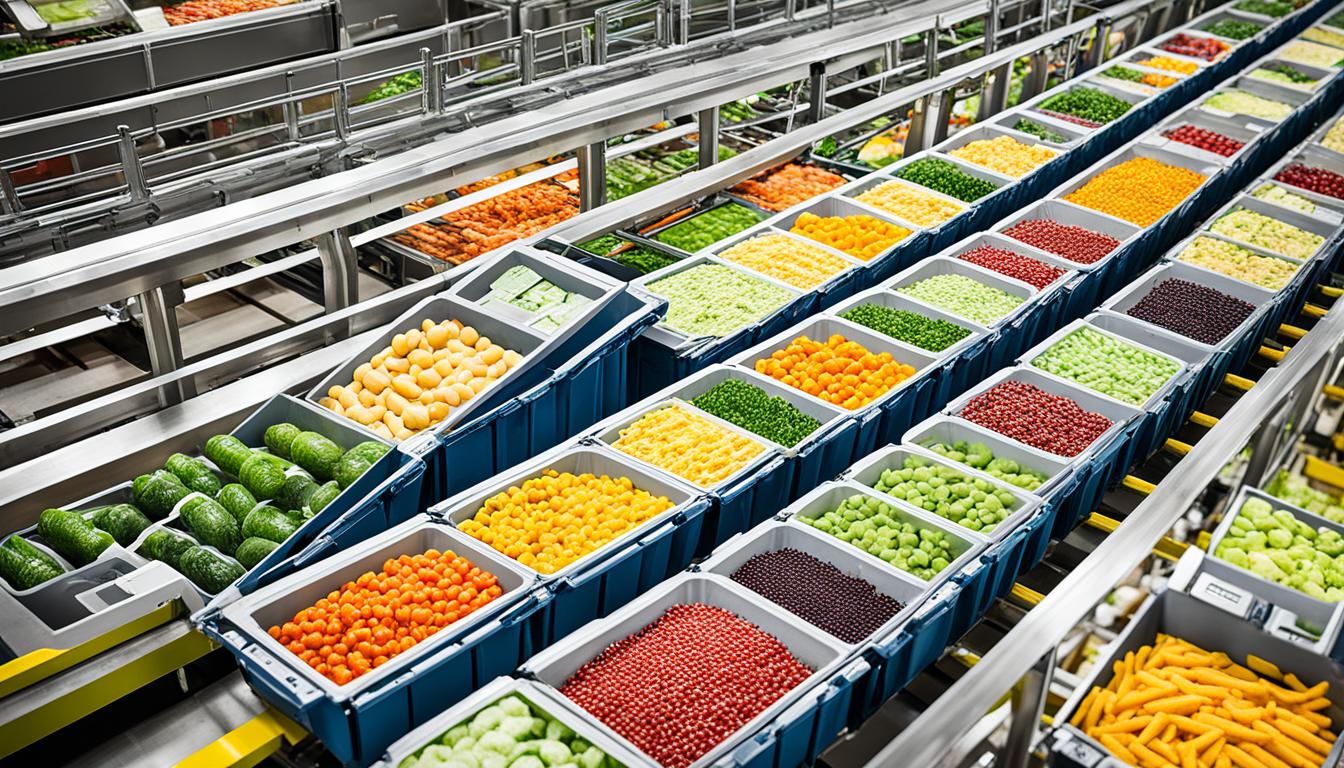
Did you know one-third of the world’s food is lost or wasted from the farm to our tables? This amounts to a huge 1 billion tonnes! It causes financial losses over $1 trillion every year and is a big factor in climate change. Making up 8-10% of greenhouse gas emissions, this is a significant issue.
It’s shocking when you think about the 1 in 10 people globally who are malnourished. Solving the food waste problem is key to both supporting our economy and saving the planet. We need everyone to work together, using the latest tech and teaching consumers, to create strong and sustainable food supply chains.
Reducing food waste is key to tackle big problems linked to the environment, economy, and health. Nearly 10% of the world’s emissions come from wasted food. This harms our planet a lot. Lost food also drains over $1 trillion from the global economy yearly.
Reducing waste can make a big difference for those in need, making food more secure. More people could be fed with less waste.
Over one-third of food made worldwide is thrown away every year. This wasted food leads to 8%-10% of all greenhouse emissions. These are as much as those of large countries add up to.
Food loss causes problems like emitting methane, cutting forests, and using too much water. If food waste was a country for emissions, it would be the third biggest after China and the U.S. Food waste might double by 2050 unless we change things now.
Throwing away food is expensive and hurts many: from farmers to families. Over $1 trillion is lost yearly. This is bad for the economy and everyone’s pocket.
Stopping food waste could save families in the UK over £700 each year. American families could save around $1,800. And restaurants can save a lot of money by investing in waste reduction. It shows we can do better with our food.
Wasting less food is good for feeding more people. Many nutritious foods don’t make it to those who need them, making hunger worse. Around 800 million people aren’t getting enough to eat, even though we waste so much food.
If we manage food waste wisely, we can help feed the hungry better. This could boost public health and nutrition globally.
To minimize food wastage, we must understand food loss and food waste. These terms are linked but have different meanings. Food loss and waste happen at various points in the supply chain. They come from different inefficiencies and stages in the system.
Food is lost early in the supply chain, while waste happens later, at the consumer level. Losses come from problems in growing, storing, and moving food. This is due to things like bad farming practices and not storing food well. Waste at the consumer level happens when we buy too much, don’t store food properly, or don’t know how to reduce waste. Food waste reduction strategies can help prevent this.
Research shows that food waste happens at every step of the supply chain. For instance, studies in the United States pinpoint the cost of food loss. In Finland, research looks at how households deal with food waste. And studies on waste at home stress the need to focus on consumers.

These studies highlight the need for a deep understanding to find good solutions. In Sweden, for example, there are efforts to stop waste in stores. Also, looking into how we manage waste shows its huge impact on the environment and economy. This shows the issue is big and affects all parts of the supply chain.
Food loss in supply chains is complex. It’s due to issues like outdated tech, poor packaging, and transport problems. These problems cause over 1 billion tonnes of food to be wasted each year. This is about one-third of all the food made around the world.
Old machinery and not enough cold storage at farms are big problems. They make food go bad faster. Also, without real-time monitoring in distribution, things get even worse.
Packaging should keep food fresh. But bad packaging can make food spoil fast. So, we need better packaging to cut down on how much food we throw away.
The way we move and store food is a big part of why we lose so much. Bad roads and not enough storage mean food gets wasted. We must improve how we transport and store food to save more.
| Cause | Impact |
|---|---|
| Inadequate Technology | Leads to inefficient harvests and accelerated spoilage due to lack of cold storage. |
| Suboptimal Packaging | Results in quicker spoilage, increasing the volume of wasted food. |
| Transportation and Storage Challenges | Exacerbate food loss through delays and poor storage conditions. |
The mix of these causes is huge. It drives a lot of the world’s greenhouse gas emissions. We must do better with tech, packaging, and transport to make our future greener.
About one-third of all food worldwide is lost or wasted. This equals over 1 billion tonnes of food. A lot of this waste comes from how we act at home, like buying too much on a whim and not storing food correctly. But we can make a big difference by shopping smart and storing our food properly.
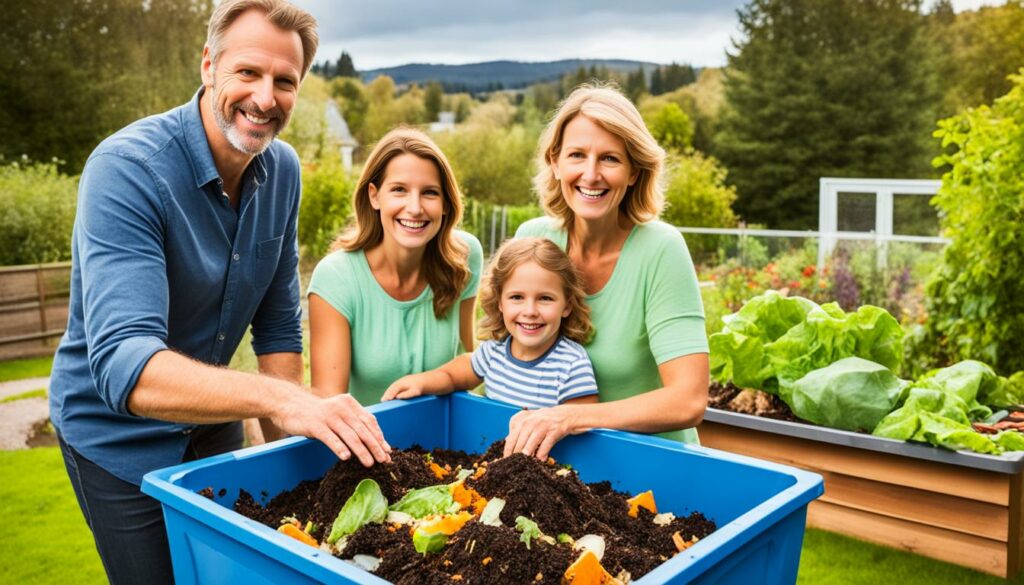
Impulse buying and buying more than we need adds to the food waste problem at home. We can avoid this by being savvy when we shop. Here’s what to do:
Storing food the right way is key to making it last longer. This stops it from going to waste. Here are some top methods:
| Aspect | Data |
|---|---|
| Global food produced | 1 billion tonnes wasted |
| Household savings (UK) | £700 annually |
| Household savings (US) | $1,800 annually |
Dealing with food waste at home is good for your pocket and the planet. By using these strategies, we can cut down on the huge amount of food we throw away and help the environment.
Dealing with food waste is key for both restaurants and shops. They waste about a third of food globally. This hurts the planet and our wallets. They can cut down by managing their stocks and serving less.
For a restaurant to waste less, it should keep a close eye on what’s in stock. This means using technology to check on their supplies in real-time. That way, they can use everything before it goes bad. Staff training also helps by teaching how to handle and store food safely.
Changing the menu often with what’s in season helps. It makes it easier to use up food before it spoils. Controlling portion sizes is also important for shops. It stops food from getting thrown away.
Donating extra food to charities is a great move for both restaurants and shops. It shows they care about the wider community and our planet. They can turn leftover food into energy and compost, like in Los Angeles and San Francisco.
Working together and being creative can really cut down on food waste. Restaurants and retailers can lead the way in being both eco-friendly and saving money.
Tackling food waste in the supply chain is key to sustainability. Advanced technology is a big part of the solution. It helps to solve these big problems.

AI changes how we deal with food waste. It lets companies find out why waste happens and fix it. Wasteless cut food waste by half and raised sales by 20% using AI.
Also, machine learning in food waste helps watch products in shops. For example, Neurolabs checked shelves in real-time, cutting waste by 40%. This tech makes sure food is stored right, lasting longer and wasted less.
Advanced analytics are crucial in reducing waste with technology. Tenzo uses AI to make sales forecasts better by 50%. This helps restaurants reduce waste. By looking deeply at their data, businesses learn to manage their supply chains smarter.
Winnow Solutions also uses AI, with scales and cameras, to watch food waste in big kitchens. It helps kitchens manage food better, cutting waste. Technology is making a big difference in waste reduction.
The mix of AI, machine learning, and advanced analytics is making our supply chains better. It helps move us closer to using our resources well and less waste. These technologies will keep getting better, playing a bigger role in saving food globally.
| Company | Technology | Impact |
|---|---|---|
| Wasteless | AI in supermarkets | 50% waste reduction, 20% revenue increase |
| Neurolabs | Real-time shelf monitoring | Up to 40% waste reduction |
| Tenzo | AI sales forecasting | 50% more accurate forecasts, reduced waste |
| Winnow Solutions | AI weighing scales and cameras | Improved kitchen waste management |
Minimising food waste the world faces is key. To do this, better inventory management and improved transportation are vital. These steps help in reducing food waste significantly.
Better supply chain starts by managing stock better. Using FIFO, where older products are sold first, lessens spoilage risk. It’s also essential to forecast demand accurately with advanced analytics. This stops you from stocking too much and then having to throw food away.
| Strategy | Impact | Examples |
|---|---|---|
| FIFO System | Reduces spoilage | Retail shelves stocked with oldest dates first |
| Supply Chain Analytics | Improves demand forecasts | Better prediction models for stock levels |
| Dynamic Shelf-Stocking | Minimises food waste | Efficient rotation of perishable items |
Improving transport to cut waste is vital. It means upgrading infrastructure to keep foods fresh in transit. Bananas, for example, must travel in precisely the right conditions to stay fresh. Companies like Hazel Technologies have found ways to make food last longer before reaching the store. They use temperature checks to keep fruits and veggies from spoiling.
These methods make a big difference in cutting waste and saving money. Working closely with suppliers and using specific packaging for each product are also important. These steps are central to a full waste reduction plan.
The use of sustainable supply chain management helps tackle key issues. It reduces food waste and lessens the harm we do to the planet. About 31% of food is wasted in the US by consumers or at stores. This waste adds up to huge numbers yearly. But, with the right steps from sourcing to delivery, we can cut these losses a lot.
Sustainable supply chain management puts a big focus on being green. We use technologies like biosensors and analytics to keep perishable foods fresh. For instance, we monitor temperatures closely to make sure products last. This way, we work on using food, not losing it.
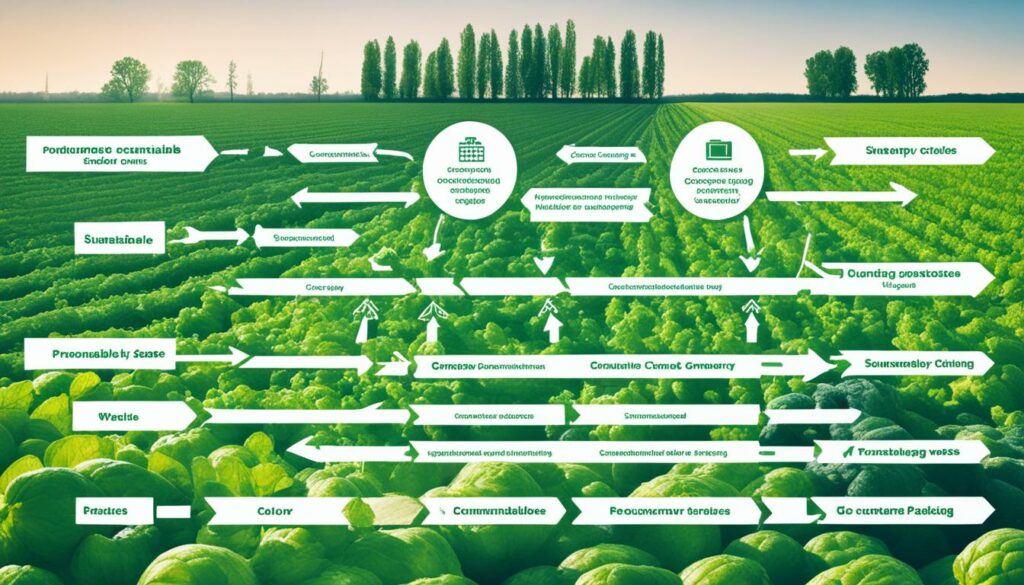
Wasting food has a big effect globally. Fruits and veg waste counts for 40% to 50% of all lost food. By planning better and keeping up with how we do things, companies are driving this number down. This includes getting our goods sustainably and working well with our suppliers.
Losing food is also a huge hit to the wallet, costing billions every year. With smarter, greener ways, companies get to save money. Plus, they appeal to more customers who care about social and green issues. This has become a global trend, showing that people all over the world prefer these responsible companies.
Using sustainable supply chain management means balancing many things. It’s not just about tech or where we get our stuff. It’s also about being good neighbours in the community and sticking to high green standards. These efforts add up to a future where we handle food better and more responsibly.
| Region | Annual Food Waste (Tonnes) | Potential Impact (People Fed Annually) |
|---|---|---|
| United States | 161 Billion USD | 54 Million |
| Europe | 200 Million People | 200 Million |
| United Kingdom | 6.7 Million Tonnes | 17.4 Million |
| Africa | 25%-50% Post-Harvest | 350 Million |
Setting up secondary markets for farm produce and expanding cosmetic standards are key. They help cut down on-farm losses. This means more food goes to consumers and less is wasted, hitting food waste issues at the root.
Secondary markets give farmers new ways to sell surplus or not-so-pretty produce. By making these markets bigger, we help food not fit the ‘normal’ look get eaten. About 21% of wasted food happens on the farm due to how the market is and what buyers want.
A wider market helps farmers be stronger against ups and downs and makes sure food gets to people efficiently.
Changing the rules on how perfect food must look can drop the amount of wasted food. This can meet what shoppers and stores want to see. Around a third of all the food made gets thrown away because it looks different.
By accepting more produce types, we stop good food from being tossed or not picked. This also eases up on needing more land to grow extra food, helping our environment.
Changing consumer habits is key to fighting the food waste issue that’s affecting us all. To make this happen, we need to educate people. This learning will help them take responsibility and make smart choices about managing food.
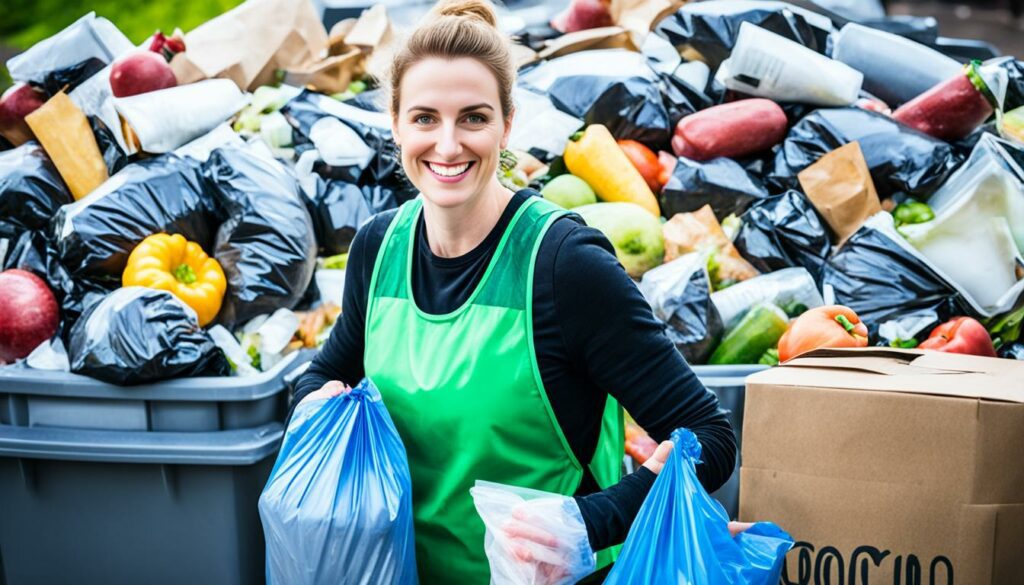
Building awareness through campaigns is vital to cut down on food waste. These efforts use many different ways to reach people, including social media and posters. They teach us about the negative impacts of food waste, such as hurting the environment and our wallets.
They also share useful tips, like buying only what we need, storing food correctly, and finding different ways to use leftovers. The goal is to get us all to be more careful with our food and reduce waste.
Teaching people, especially young ones, about the importance of food can make a big difference in the long run. Programs in schools show children how to waste less food and why it matters. This sets them up to have good habits for life.
There are also classes and online resources for grown-ups. They learn how to cut back on the food they throw away. This type of education can really change how people think about using food better.
| Impact Area | Details |
|---|---|
| Environmental | Food comprises 24% of municipal solid waste in landfills, making it the most common material found in landfills. Reducing waste mitigates environmental damage. |
| Economic | Food loss and waste, including surplus food, is valued at $444 billion in 2021, representing roughly 2% of the U.S. gross domestic product. |
| Social | Educating consumers encourages responsible food management, helps combat food insecurity, and aligns with the UN’s goal of halving food waste by 2030. |
Using a structured approach to educating consumers can really cut down on food waste. This in turn helps us move towards a more sustainable way of living.
Innovative food packaging plays a big role in keeping our food fresh longer. This is vital for reducing waste and maintaining high quality. New packaging advancements help significantly in cutting food spoilage and waste.
Innovative packaging helps food last longer. For example, with AI technology, food stays fresh up to 40% longer. This reduces the amount of food thrown away.AI in packaging uses data to choose the best route in the supply chain. This improves efficiency and keeps food fresh. AI also means real-time checks on the food’s condition. It uses sensors and tags to make sure food is well-kept. This leads to less spoilage and better quality.
New types of food packaging also cut down on waste. They’re made from materials that can be recycled or break down naturally. These materials protect food from going bad but are kind to the environment.By using better packaging, food can last longer. This means we throw away less. These improvements could prevent 26% to 50% of food waste. It’s a big help in keeping our world clean and cutting down on harmful greenhouse gases.
The table below highlights some key strategies and their benefits:
| Strategy | Benefits |
|---|---|
| AI-Enabled Packaging | Extends shelf life, real-time monitoring, reduces spoilage |
| Recyclable/Biodegradable Materials | Environmentally friendly, reduces contamination, sustainable |
| High-Quality Materials | Longer freshness, less food waste, cost-efficient |
| Modified Atmosphere Packaging | Prevents spoilage, extends shelf life, maintains quality |
| Real-Time Sensors & RFID Tags | Ensures quality control, optimal preservation, data-driven |
Reducing food waste helps in many ways. It boosts food security, saves money, and helps the planet. Sorting out food waste tackles big moral and economic issues.
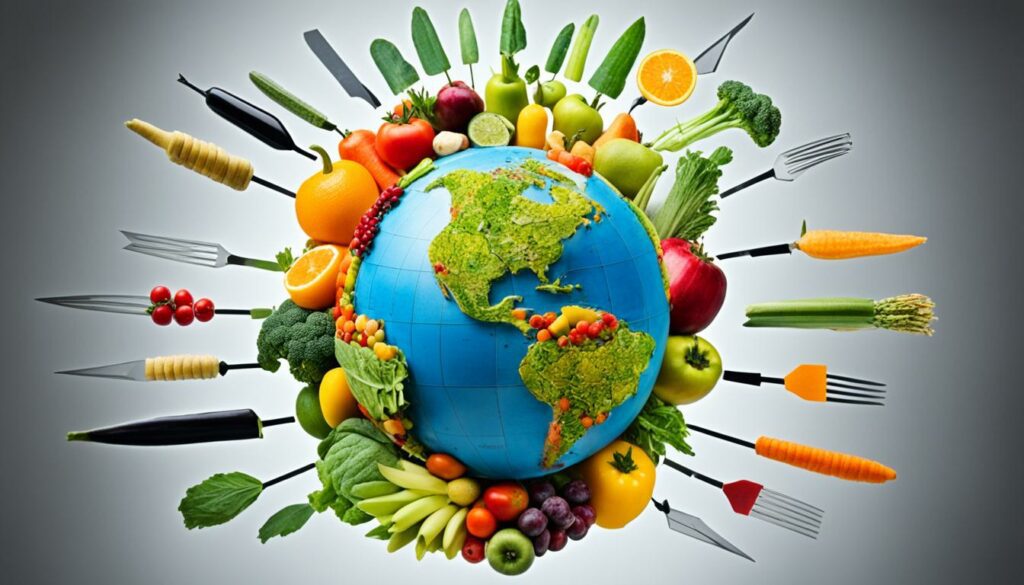
Each year, over 1 billion tonnes of food is wasted. But, 1 in 10 people still go hungry. By giving uneaten food to those who need it, we can feed more people. Right now, 24% of food globally goes uneaten. This is serious because food waste might double by 2050.
The money saved from less waste is huge. Globally, wasted food costs over $1 trillion a year. By 2030, if businesses cut waste by 20%-25%, they could save between $120-$300 billion. Families can also save a lot. For example, those in the U.S. can save about $1,800 yearly and in the UK, more than £700 ($870). These savings are from both lower food bills and less money spent on garbage.
Reducing waste helps the planet a lot. Food waste makes 8%-10% of global greenhouse gases. Less waste means fighting climate change. It also saves natural resources and stops cutting down forests. With more than 40% of food wasted every year, it’s vital for a healthy planet.
The U.S. faces a big problem with food waste. Around 38% of all food is not sold or not eaten. This means we waste 145 billion meals every year. It shows we really need strong food waste prevention policies and laws to tackle this issue. This waste impacts the economy by causing about $473 billion in losses, or 1.8% of the U.S. GDP. It also leads to a lot of greenhouse gas emissions. This is why it’s crucial to have legislation impact on waste reduction for real change.
Government efforts are key to fighting food waste. Investing in this area is very effective. According to ReFED, putting $18 billion each year, with some help of $4.7 billion from special sources, could cut food waste by over 21 million tons annually. This leads to a Net financial gain of $78 billion every year. ReFED’s plan to 2030 and their Policy Finder are great to understand and use federal and state laws.
The corporate world also plays a major part in waste minimisation. Companies can use many ways to lessen food waste. This includes choosing ethical food suppliers and doing detailed waste checks. They should also aim to be more sustainable. Using tools like ReFED’s Insights Engine for detailed advice and data on leftover food can help firms make smart choices for waste reduction. By sticking to these methods, companies can help cut down food waste and its negative effects a lot.
| Initiative | Impact | Financial Benefit |
|---|---|---|
| Annual Investment | Reduce 21 million tons | $78 billion |
| Government Policies | Regulatory Support | N/A |
| Corporate Responsibility | Ethical Sourcing, Audits | Varies by Company |
Dealing with food waste needs action from all, from leaders to families. We must reduce waste at every step of the food journey. Sadly, in the EU-28 area, each person throws away 180 kilograms of food yearly, which is a quarter of their food buy. China throws away food value at $32 billion every year, and the U.S. wastes 40% of its food, costing about $165 billion.
The way food is moved and stored leads to 1.3 billion tonnes of yearly waste globally. To stop this, we can use new technology, better storage, and smarter packaging. For example, tech on the farm and better ways to move food can make the system work better. This also helps in making just the right amount of food and handling it after it’s picked much better.
Teaching people why food waste is bad and how to use food better is vital. It’s been shown that we need to really get why those in charge of getting our food use or don’t use new ideas. This way, by working together smartly, we can make changes that are good for our planet in the long run. This means setting up a food system that is both better at its job and cares for the Earth more, for the people who come after us.
The main goals involve using sustainable food distribution and opting for effective supply chain methods. Plus, we use technology to track and decrease waste.
Food waste greatly adds to greenhouse gas emissions, making up 10% of the world’s total. These emissions come from producing, moving, and spoiling food, which all worsens climate change.
Each year, food waste costs more than
The main goals involve using sustainable food distribution and opting for effective supply chain methods. Plus, we use technology to track and decrease waste.
Food waste greatly adds to greenhouse gas emissions, making up 10% of the world’s total. These emissions come from producing, moving, and spoiling food, which all worsens climate change.
Each year, food waste costs more than $1 trillion. This impacts everyone by raising food prices, wasting resources, and putting a strain on economies.
Less waste means more nutritious food for people. This boosts nutrition and food safety worldwide. It also ensures that valuable food doesn’t go to waste.
Food loss happens as it’s produced, stored, and transported. This is due to old tech or bad packaging. Food waste is what’s thrown away at home or in restaurants by customers.
Issues like old tech for cold storage and bad packaging can lead to spoilage. There are also problems in getting food from place to place. Finding better solutions for these problems is important.
Buying only what you need and learning how to store food well are great ways for consumers to cut down on waste.
They can manage their stock better, train staff to handle food well, and offer menus that use up food wisely. Donating extra food is also a great way to avoid wastage.
AI, machine learning, and analytics can help predict what’s needed, manage stock better, and make buying food more efficient. This makes supply chains smarter and less wasteful.
Good practices include guessing demand accurately and improving how food moves around. These practices lower the chance of food going bad before it’s used.
By following eco-friendly steps, like selling fair trade and not wasting resources, supply chains can cut down on waste throughout the process.
Secondary markets give another way to sell food that’s too much or doesn’t look perfect. This stops a lot of food from being wasted and helps farmers make more money.
Teaching people about food waste’s effect and how to manage food better can lead to less waste. This includes knowing how to read date labels properly.
Packaging that keeps food fresh longer and doesn’t create a lot of waste is helping to decrease the amount of food we throw out.
Less food waste means more food security and saves money, which is good for the economy. It also cuts down on emissions and saves resources.
Leadership from governments and businesses is needed. This includes clear rules on date labels, rewards for waste reduction, and backing new ideas. It also involves choosing food sources carefully and checking waste often.
Less waste means more nutritious food for people. This boosts nutrition and food safety worldwide. It also ensures that valuable food doesn’t go to waste.
Food loss happens as it’s produced, stored, and transported. This is due to old tech or bad packaging. Food waste is what’s thrown away at home or in restaurants by customers.
Issues like old tech for cold storage and bad packaging can lead to spoilage. There are also problems in getting food from place to place. Finding better solutions for these problems is important.
Buying only what you need and learning how to store food well are great ways for consumers to cut down on waste.
They can manage their stock better, train staff to handle food well, and offer menus that use up food wisely. Donating extra food is also a great way to avoid wastage.
AI, machine learning, and analytics can help predict what’s needed, manage stock better, and make buying food more efficient. This makes supply chains smarter and less wasteful.
Good practices include guessing demand accurately and improving how food moves around. These practices lower the chance of food going bad before it’s used.
By following eco-friendly steps, like selling fair trade and not wasting resources, supply chains can cut down on waste throughout the process.
Secondary markets give another way to sell food that’s too much or doesn’t look perfect. This stops a lot of food from being wasted and helps farmers make more money.
Teaching people about food waste’s effect and how to manage food better can lead to less waste. This includes knowing how to read date labels properly.
Packaging that keeps food fresh longer and doesn’t create a lot of waste is helping to decrease the amount of food we throw out.
Less food waste means more food security and saves money, which is good for the economy. It also cuts down on emissions and saves resources.
Leadership from governments and businesses is needed. This includes clear rules on date labels, rewards for waste reduction, and backing new ideas. It also involves choosing food sources carefully and checking waste often.